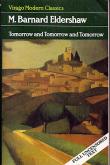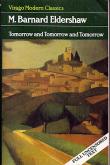AustLit
Latest Issues
AbstractHistoryArchive Description
'Tomorrow is a novel within a novel. Knarf (read it backwards and remember Dalby Davison) is a 24-century novelist who has written an historical novel about a group of Sydney people in the 20th century.
'His story begins in the 20s, runs through the Depression, faithfully describes the course of WWII until the time when the date catches up with the story, and Marjorie had to begin to prophesy'. Source: review 'The Censorship of Yesterday Hid a Great Tomorrow'.
Notes
-
Also published in sound recording format.
Publication Details of Only Known VersionEarliest 2 Known Versions of
Works about this Work
-
'Dystopia' : A History of the Genre in (and) Australia
2020
single work
criticism
— Appears in: Beyond the Dark : Dystopian Texts in the Secondary English Classroom 2020; (p. 8-34) -
Foreword
2020
single work
criticism
— Appears in: Beyond the Dark : Dystopian Texts in the Secondary English Classroom 2020; (p. viii-x) -
y
 Reflectant Tides : The Aqueous Poetics of Sydney in Women's Fiction, 1934-1947
Penrith
:
2018
18029044
2018
single work
thesis
Reflectant Tides : The Aqueous Poetics of Sydney in Women's Fiction, 1934-1947
Penrith
:
2018
18029044
2018
single work
thesis
'In Sydney, the period between the two world wars was a time of rapid change, when ‘modern’ was considered a goal to which the city and its people should strive. The 1930s were bookended by the opening of the Harbour Bridge in 1932 and the 1938 Sesquicentenary of the First Fleet’s landing, two events that figured Sydney as the triumphant end point of a narrative of national, white Australian progress. This period also saw the publication of a number of novels by Australian women writers that took the contemporary city as their setting and scrutinised urban modernity as a state of being and an ideological position. This thesis takes as its focus five novels that depict and debate the multiple and often combative discourses of modernity that flowed through Australia’s first and most populous urban centre in the interwar period: Seven Poor Men of Sydney (1934) by Christina Stead, Jungfrau (1936) by Dymphna Cusack, Waterway (1938) by Eleanor Dark, Foveaux (1939) by Kylie Tennant, and Tomorrow and Tomorrow and Tomorrow (1947; 1983) by M. Barnard Eldershaw. Through close reading within and across the novels, I argue that this generation of women writers pioneered a distinctly Australian, modern urban poetics that is best described as aqueous. Responding to Sydney as a dynamic estuarine environment, each writer mobilises water as location and literary device, infusing the modern city’s spaces and processes with productively aqueous qualities of changeability and circulation, unsettlement and motility. Making heuristic use of a Benjaminian framework for dialectical urban thinking, I read this aqueous poetics of Sydney against the narrative of progress epitomised by the Bridge and Sesquicentenary, arguing that in contradistinction to this narrative, the novels present an Australian urban modernity of material emplacement in an unpredictably watery sphere, where history settles and sediments, multiple ideological schemas flow into one another, and relations between bodies, space and power generate constant contestation.'
Source: Abstract.
-
The Case of the Trashy, Tripey Novel with a Marxist Slant : M Barnard Eldershaw and Science Fiction
2017
single work
essay
— Appears in: Aurealis , no. 102 2017; -
Apocalyse Vs Utopia : A Writers Guide
2014
single work
essay
— Appears in: Southerly , vol. 74 no. 1 2014; (p. 90-102)
-
Tomorrow and Tomorrow (and also Tomorrow)
2001
single work
review
— Appears in: Notes on Australian Science Fiction 2001; (p. 35-37)
— Review of Tomorrow and Tomorrow 1947 single work novel -
Comparing the Critics : 'Two of a Trade Can Ne'er Agree'
1950
single work
review
— Appears in: The Austrovert , December no. 1 1950; (p. 7)
— Review of Tomorrow and Tomorrow 1947 single work novel ; Dusty : The Story of a Sheep Dog 1946 single work children's fiction ; Dust or Polish? 1950 single work novel -
Classical View of Wartime
1983
single work
review
— Appears in: The Age , 27 August 1983; (p. 10)
— Review of Tomorrow and Tomorrow 1947 single work novel -
The Censorship of Yesterday Hid a Great Tomorrow
1983
single work
review
— Appears in: The Weekend Australian Magazine , 10-11 September 1983; (p. 14)
— Review of Tomorrow and Tomorrow 1947 single work novel ; The Roaring Nineties : A Story of the Goldfields in Western Australia 1946 single work novel -
Prophetic Classic Restored
1983
single work
review
— Appears in: The Canberra Times , 22 October 1983; (p. 16)
— Review of Tomorrow and Tomorrow 1947 single work novel -
The Golden Age of Australian Science Fiction
1995
single work
column
— Appears in: Science Fiction : A Review of Speculative Literature , vol. 12 no. 3 (Issue 36) 1995; (p. 3-28) -
Memory, Community, and Writing in Tomorrow and Tomorrow and Tomorrow
2004
single work
criticism
— Appears in: Southerly , vol. 64 no. 1 2004; (p. 101-114) Explores the themes of memory, forms of community, and the writing process itself in the work Tomorrow and Tomorrow. -
The Bonds of Friendship : The Demise of 'M. Barnard Eldershaw'
2004
single work
criticism
— Appears in: Hecate , vol. 30 no. 2 2004; (p. 129-147) The article examines the development leading to the end of the collaboration between Barnard and Eldershaw and explores elements of tension within the collaboration in an attempt to find out why Barnard in her later comments consistently tried to diminish Eldershaw's contribution to the latter stages of their partnership. From letters examined and comments in Nettie Palmer's diary, Dever concludes that Barnard's relationship with Frank Dalby Davison, and the role he played in the group of friends, had a considerable impact on the partnership and on the way Barnard presented the collaboration after Eldershaw's death. -
Writing the 'Fatal Moment' : Crisis, Community and the Literary Imagination in M. Barnard Eldershaw's Tomorrow and Tomorrow and Tomorrow
2005
single work
criticism
— Appears in: JASAL , vol. 4 no. 2005; (p. 121-132) Proposes a fresh reading of the novel as being essentially 'about writers and writing, and how they fit into the world around them' (p.121). -
Around the World
1947
single work
column
— Appears in: The Australasian Book News and Literary Journal , November vol. 2 no. 5 1947; (p. 280)
- New South Wales,
- Sydney, New South Wales,
- Bush,
- Urban,
- 1930s
- 1940s
- 2300-2399
- 2400-2450





